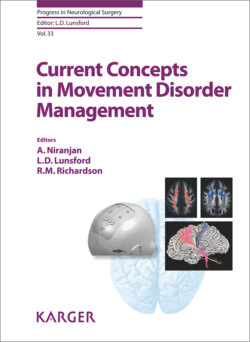Читать книгу Current Concepts in Movement Disorder Management - Группа авторов - Страница 40
References
Оглавление1Alexander GE, DeLong MR, Strick PL: Parallel organization of functionally segregated circuits linking basal ganglia and cortex. Annu Rev Neurosci 1986;9:357–381.
2Bostan AC, Dum RP, Strick PL: Cerebellar networks with the cerebral cortex and basal ganglia. Trends Cogn Sci 2013;17:241–254.
3Braak H, Del Tredici K, Rub U, de Vos RA, Jansen Steur EN, Braak E: Staging of brain pathology related to sporadic Parkinson’s disease. Neurobiol Aging 2003;24:197–211.
4Galvan A, Devergnas A, Wichmann T: Alterations in neuronal activity in basal ganglia-thalamocortical circuits in the parkinsonian state. Front Neuroanat 2015;9:5.
5Little S, Pogosyan A, Neal S, Zavala B, Zrinzo L, Hariz M, Foltynie T, Limousin P, Ashkan K, Fitzgerald J, Green AL, Aziz TZ, Brown P: Adaptive deep brain stimulation in advanced Parkinson disease. Ann Neurol 2013;74:449–457.
6Bernheimer H, Birkmayer W, Hornykiewicz O, Jellinger K, Seitelberger F: Brain dopamine and the syndromes of Parkinson and Huntington. J Neurol Sci 1973;20:415–455.
7Rommelfanger KS, Wichmann T: Extrastriatal dopaminergic circuits of the basal ganglia. Front Neuroanat 2010;4:139.
8Smith Y, Galvan A, Ellender TJ, Doig N, Villalba RM, Huerta-Ocampo I, Wichmann T, Bolam JP: The thalamostriatal system in normal and diseased states. Front Syst Neurosci 2014;8:5.
9Mathai A, Ma Y, Pare JF, Villalba RM, Wichmann T, Smith Y: Reduced cortical innervation of the subthalamic nucleus in MPTP-treated parkinsonian monkeys. Brain 2015;138:946–962.
10Grabli D, Karachi C, Folgoas E, Monfort M, Tande D, Clark S, Civelli O, Hirsch EC, Francois C: Gait disorders in parkinsonian monkeys with pedunculopontine nucleus lesions: a tale of two systems. J Neurosci 2013;33:11986–11993.
11Klein C: Genetics in dystonia. Parkinsonism Relat Disord 2014;20(suppl 1):S137–S142.
12Vidailhet M, Jutras MF, Grabli D, Roze E: Deep brain stimulation for dystonia. J Neurol Neurosurg Psychiatry 2013;84:1029–1042.
13Karimi M, Perlmutter JS: The role of dopamine and dopaminergic pathways in dystonia: insights from neuroimaging. Tremor Other Hyperkinet Mov (N Y) 2015;5:280.
14Sciamanna G, Tassone A, Martella G, Mandolesi G, Puglisi F, Cuomo D, Madeo G, Ponterio G, Standaert DG, Bonsi P, Pisani A: Developmental profile of the aberrant dopamine D2 receptor response in striatal cholinergic interneurons in DYT1 dystonia. PLoS One 2011;6:e24261.
15Schrock LE, Ostrem JL, Turner RS, Shimamoto SA, Starr PA: The subthalamic nucleus in primary dystonia: single-unit discharge characteristics. J Neurophys 2009;102:3740–3752.
16Wilson BK, Hess EJ: Animal models for dystonia. Mov Disord 2013;28:982–989.
17Calderon DP, Fremont R, Kraenzlin F, Khodakhah K: The neural substrates of rapid-onset Dystonia-Parkinsonism. Nat Neurosci 2011;14:357–365.
18Fan X, Hughes KE, Jinnah HA, Hess EJ: Selective and sustained α-amino-3-hydroxy-5-methyl-4-isoxazolepropionic acid receptor activation in cerebellum induces dystonia in mice. J Pharmacol Exp Ther 2012;340:733–741.
19Niethammer M, Carbon M, Argyelan M, Eidelberg D: Hereditary dystonia as a neurodevelopmental circuit disorder: evidence from neuroimaging. Neurobiol Dis 2011;42:202–209.
20Prudente CN, Hess EJ, Jinnah HA: Dystonia as a network disorder: what is the role of the cerebellum? Neurosci 2014;260:23–35.
21Breakefield XO, Blood AJ, Li Y, Hallett M, Hanson PI, Standaert DG: The pathophysiological basis of dystonias. Nat Rev Neurosci 2008;9:222–234.
22Louis ED, Ottman R: How many people in the USA have essential tremor? Deriving a population estimate based on epidemiological data. Tremor Other Hyperkinet Mov (N Y) 2014;4:259.
23Schmouth JF, Dion PA, Rouleau GA: Genetics of essential tremor: from phenotype to genes, insights from both human and mouse studies. Prog Neurobiol 2014;119–120:1–19.
24Louis ED: Essential Tremor: A Common Disorder of Purkinje Neurons? Neuroscientist 2016;22:108–118.
25Hallett M: Tremor: pathophysiology. Parkinsonism Relat Disord 2014;20(suppl 1):S118–S122.
26Handforth A: Harmaline tremor: underlying mechanisms in a potential animal model of essential tremor. Tremor Other Hyperkinet Mov (N Y) 2012;2:pii:02-92-769-1.
Thomas Wichmann, MD
A. Worley Brown Professor of Neurology
Emory University, School of Medicine, Yerkes Center
954 Gatewood Road, NE
Atlanta, GA 30329 (USA)
E-Mail twichma@emory.edu
